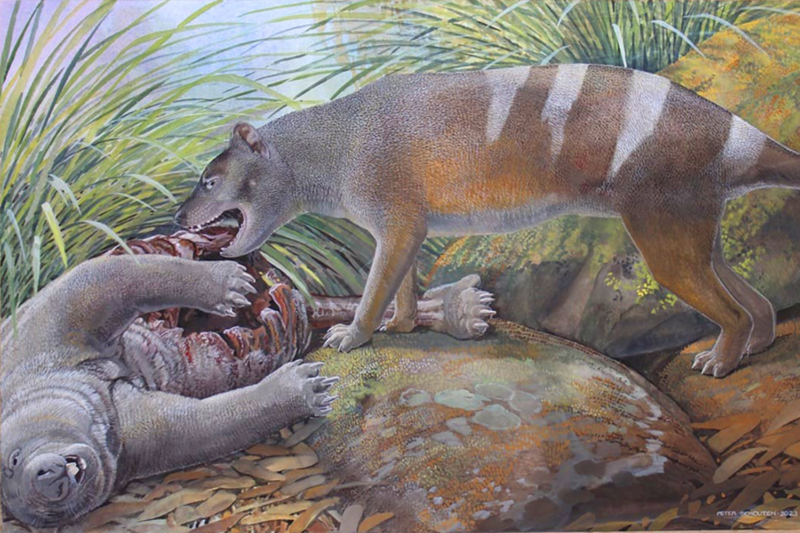Earliest known ancestors of the extinct Tasmanian Tiger discovered – and some could even eat the bones and teeth of their prey


Artist’s reconstruction of Badjcinus timfaulkneri scavenging on the carcass of Silvabestius michaelbirti, a wombat-like marsupial also from Hiatus Site. Illustration by Peter Schouten.
Findings are published today, Australia’s National Threatened Species Day, which marks the death of the very last Tasmanian Tiger on 7th September 1936
A marsupial which had an “extremely thick” jawbone, enabling it to consume even the bones and teeth of its prey is among a discovery of three, new ancient species of the modern Thylacines – otherwise known as the Tasmanian tiger, which went extinct 88 years ago.
These new species each roamed Australia around 23-to-25 million years ago, during the late Oligocene, making them the “undoubted oldest members of this family ever discovered”.
Today – Australia’s National Threatened Species Day, which marks the death of the last Tasmanian Tiger in Hobart’s Beaumaris Zoo on the 7th of September 1936 – scientists from the University of New South Wales (UNSW) Vertebrate Palaeontology Lab publish their findings in the Journal of Vertebrate Paleontology.
“The once suggested idea that Australia was dominated by reptilian carnivores during these 25 million-year-long intervals is steadily being dismantled as the fossil record of marsupial carnivores, such as these new thylacinids, increases with each new discovery,” explains lead author Timothy Churchill, a PhD student at UNSW.
“The diversity of mammalian carnivores at Riversleigh during this period rivals that seen in any other ecosystem, including the great mammalian carnivore radiation that developed in South America.”
The three new species were each found in the fossil-rich deposits in Riversleigh World Heritage Area.
The largest of these new species, Badjcinus timfaulkneri, weighed somewhere between 7-11 kilograms, about the same size as a large Tasmanian Devil. Alike the Tasmanian Devil, timfaulkneri possessed an extremely thick jawbone enabling it to consume the bones and teeth of its prey. This species is related to the much smaller, previously discovered B. turnbulli (2.7 kg) – which until now was the only other undoubted thylacinid known from the late Oligocene.
The dentary and isolated first molar of B. timfaulkneri were recovered from Hiatus Site which is even older than Riversleigh’s White Hunter Site where B. turnbulli was previously found, making B. timfaulkneri the oldest undoubted thylacine discovered so far.
Badjcinus timfaulkneri is named after Tim Faulkner, the director and co-owner of the Australian Reptile Park and managing director of Aussie Ark. Tim has dedicated his life to the conservation of Australia’s wildlife including the largest still-living marsupial carnivore, the Tasmanian Devil.
The second new species is Nimbacinus peterbridgei. This was about the size of a Maltese Terrier (~3.7 kg). This species is represented by a near-complete dentary from White Hunter Site. Nimbacinus peterbridgei was a predator that probably focused on small mammals and other diverse prey species that lived with it in the ancient forests. Species of Nimbacinus appear to be more closely related to the Tasmanian Tiger than other thylacinids of similar age. This means Nimbacinus peterbridgei is probably the oldest direct ancestor of the Tasmanian Tiger yet known.
Nimbacinus peterbridgei was named after Australian geologist, speleologist and bibliophile Peter Bridge. He has devoted his life to helping uncover Australia’s ancient past, particularly in the caves of Western Australia.
The last species, Ngamalacinus nigelmarveni was a ~5.1kg thylacinid – approximately the size of a Red fox. It was also from White Hunter Site at Riversleigh. The blades on the lower molars of species of Ngamalacinus are elongated with deep V-shaped carnassial (‘meat-cutting’) notches, suggesting they were highly carnivorous – more so than any of the other thylacinids of similar size.
Ngamalacinus nigelmarveni is named after Nigel Marven, a renowned British television documentary presenter famous for paleontology-inspired series like Prehistoric Park and Sea Monsters.
Summarising the team’s findings, co-author Professor Michael Archer says: “The presence of three distinct lineages of specialised thylacinids during the late Oligocene highlights how quickly they diversified after first appearing in the fossil record.
“These thylacinids exhibits very different dental adaptations, suggesting there were several unique carnivorous niches available during this period. All but one of these lineages, the one that led to the modern Thylacine, became extinct around 8 million years ago.
“That lineage of these creatures that survived for more than 25 million years ended with the death of Benjamin, the last Tasmanian Tiger in Hobart’s Beaumaris Zoo on the 7th of September 1936.”